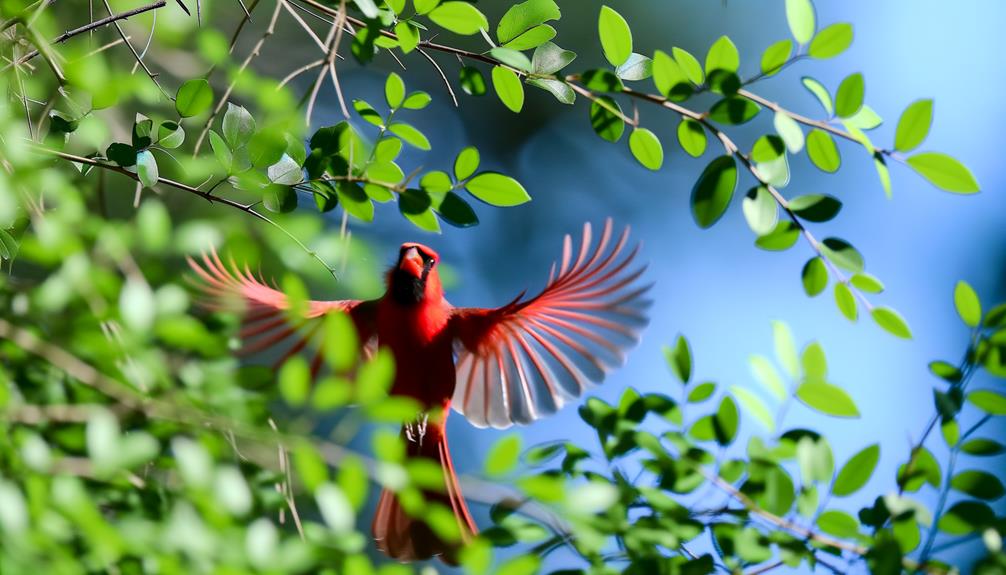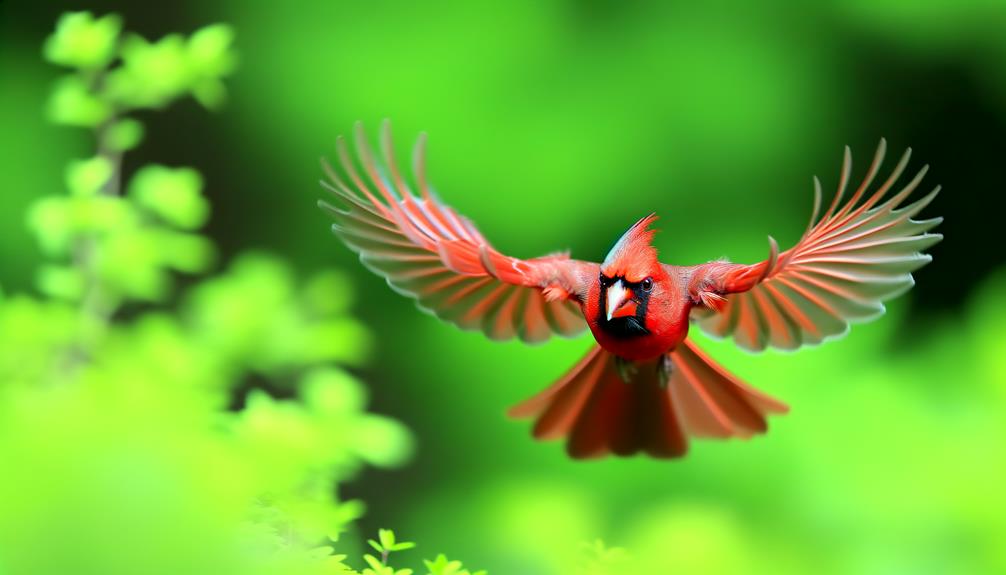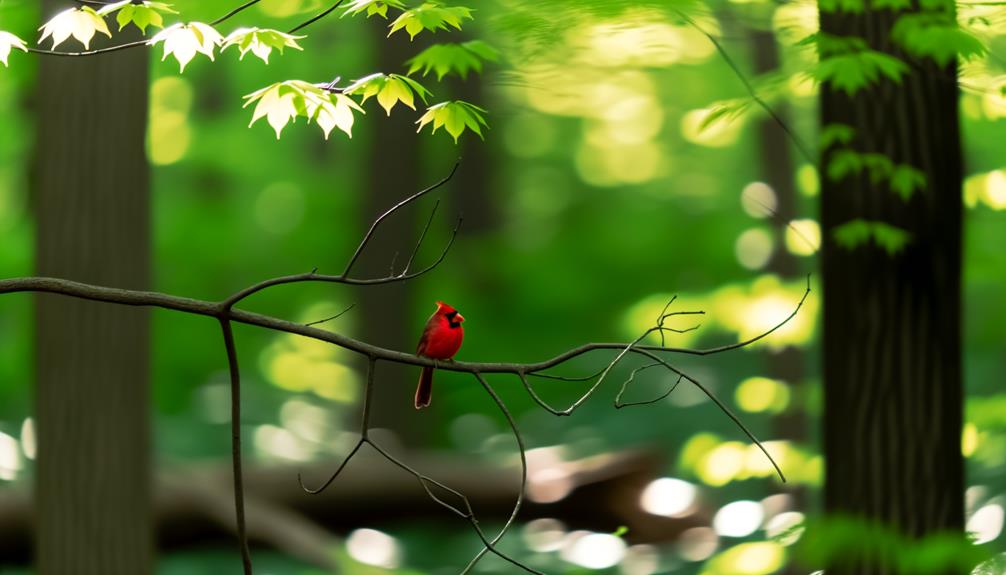A Cardinal Keeps Flying Near Me: Behavioral Insights
A cardinal often flying close to you may be because of its strongly territorial behavior and attraction to the thick foliage or food sources around your vicinity. These birds are attracted to areas with plenty of seeds, especially sunflower and safflower.
Their inclination for such environments guarantees they have the essential resources for nesting and feeding. Furthermore, cardinals exhibit monogamous behavior, frequently observed in pairs protecting their territory.
Their vibrant feathers and melodious singing indicate their presence and territory to possible competitors or partners. For a more profound comprehension of their fascinating behavior and importance, delve further into their habits and symbolism.

Key Takeaways
- Cardinals may be attracted to feeders stocked with sunflower seeds, safflower seeds, and cracked corn.
- Cardinals symbolize spiritual messages, often considered as signs from departed loved ones.
- Territorial behavior leads cardinals to frequently return to defend their chosen space.
- Seasonal patterns and photoperiod cues influence cardinal activity and presence.
- Cardinals prefer habitats with dense vegetation, providing food and shelter.
5 Aspects: Why a Cardinal May Keep Flying Near You
| Aspect | Details |
|---|---|
| Territorial Behavior | Cardinals are highly territorial, especially during breeding season, and may fly near humans to protect their space. |
| Curiosity | Cardinals are curious birds and may approach humans, especially if they are used to being around people. |
| Reflection Misinterpretation | A cardinal may see its reflection in windows or mirrors and think it’s a rival, causing it to fly near repeatedly. |
| Food Sources | If you have bird feeders or plants that attract insects, the cardinal may be flying near to feed. |
| Symbolic or Cultural Significance | Some people interpret frequent cardinal visits as a spiritual or symbolic sign, though this is a personal belief. |
Cardinal Characteristics

A cardinal, characterized by its vibrant red plumage and distinctive crest, often catches your attention due to its striking appearance. You can identify males by their brilliant red feathers, while females display a more subdued reddish-brown hue.
The black mask around the face and throat contrasts sharply with their body, enhancing their visibility. Cardinals exhibit sexual dimorphism, meaning males and females differ in appearance. Their robust, conical beak is perfectly adapted for cracking seeds, their primary diet.
Observing their behavior, you’ll notice they’re monogamous, often seen in pairs, especially during breeding season. Their melodic song, a series of clear whistles, serves as both a mating call and a territorial warning, showcasing their complex vocal abilities.
Habitat and Distribution
You’ll often find cardinals inhabiting woodlands, gardens, and shrublands, where they thrive in dense, tangled vegetation that provides both food and shelter. These vibrant birds prefer areas with a mix of trees and underbrush, offering safety from predators and abundant nesting sites. Their distribution spans across North, Central, and South America, adapting to various climates and altitudes.
Observing their habitat preferences can be enlightening:
| Habitat Type | Cardinal Behavior |
|---|---|
| Woodlands | Foraging in thick undergrowth |
| Gardens | Nesting in hedges and shrubs |
| Shrublands | Singing from dense thickets |
You’ll notice that cardinals are highly territorial, often seen defending their chosen space with fervor. Their adaptability to different environments underscores their resilience and freedom in the avian world.
Seasonal Patterns

You’ll notice that cardinals exhibit distinct seasonal patterns, especially in their migration and breeding cycles.
Research shows that weather greatly influences their behavior, with temperature fluctuations impacting their feeding and nesting habits.
Migration and Breeding Cycles
Observing the cardinal’s migration and breeding cycles reveals intricate seasonal patterns that are critical for understanding their behavior and habitat preferences. You’ll notice that these vibrant birds exhibit a complex interplay of timing and environmental cues. During the breeding season, cardinals establish territories and build nests, often preferring dense thickets and shrubbery.
Their migration patterns are less pronounced compared to other birds, yet they still exhibit subtle seasonal movements.
- Nest-building in early spring
- Territorial singing to attract mates
- Raising multiple broods per season
- Shifting to abundant food sources in winter
- Using photoperiod cues for breeding readiness
Weather Influence on Behavior
Understanding the cardinal’s migration and breeding cycles provides a foundation to explore how weather patterns significantly influence their behavior throughout the seasons. Cardinals don’t migrate, so they adapt to local weather variations.
In spring, increasing daylight and warmer temperatures trigger breeding behaviors. Males sing more frequently to establish territories.
Summer’s heat can lead them to seek shaded areas and water sources. During autumn, they molt, replacing worn feathers for better insulation.
Winter’s cold prompts them to forage more aggressively, often visiting feeders. Research shows that extreme weather, such as storms or sudden temperature drops, can disrupt these patterns temporarily.
Attraction to Feeders
Cardinals are particularly drawn to feeders stocked with sunflower seeds, safflower seeds, and cracked corn, showcasing a strong preference for these food sources. Through detailed observation, researchers have identified these seeds as primary attractants due to their high-energy content and easy accessibility.
When you set up a feeder with these seeds, you’ll notice cardinals visiting more frequently and staying longer, enhancing your bird-watching experience.
- Burst of vibrant red plumage
- Gentle, melodic chirping
- Graceful, fluttering movements
- Excitement of a close encounter
- Connection to nature’s freedom
Territorial Behavior

When a cardinal exhibits its territorial behavior, it often engages in assertive displays such as singing from prominent perches and chasing away intruders to defend its chosen area.
You’ll observe the male cardinal’s persistent and loud vocalizations, serving as auditory markers, delineating boundaries. This behavior peaks during early morning and late afternoon, when territorial defense is most important.
Research shows that cardinals can recognize individual rivals by their calls, allowing them to target specific intruders. Visual displays, including wing flicking and crest raising, further reinforce their dominance.
Mating Rituals
During the mating season, the male cardinal’s vibrant plumage and melodious songs play an important role in attracting a suitable mate. His bright red feathers signal good health and genetic fitness, while his complex vocalizations demonstrate territory control and resource availability.
You can observe these behaviors as he performs:
- Courtship Feeding: Offering food to the female to showcase his ability to provide.
- Song Duets: Engaging in back-and-forth singing to strengthen pair bonds.
- Nest Site Selection: Helping choose and build a secure nesting location.
- Territorial Displays: Defending their area from rivals to secure safety.
- Mating Dances: Performing elaborate movements to captivate the female.
These rituals are carefully orchestrated, highlighting the cardinal’s dedication to reproductive success and freedom in the wild.
Symbolism in Culture

You might find it fascinating that cardinals are often considered messengers in various cultures, symbolizing communication from the spiritual domain.
Research indicates that many indigenous and contemporary belief systems attribute a cardinal’s presence to significant spiritual events or messages.
Observations show that these birds frequently appear during times of personal transformation or emotional upheaval, highlighting their profound cultural and spiritual significance.
Cardinal as a Messenger
In diverse cultures, cardinals are often seen as messengers of the spiritual domain, symbolizing guidance and the presence of loved ones. Research indicates that these vibrant birds appear during significant moments, providing comfort and direction. Observations suggest cardinals may serve as:
- Beacons of hope during times of despair
- Symbols of continuity connecting past, present, and future
- Harbingers of change signaling new beginnings
- Emissaries of love from those who’ve passed away
- Guardians of wisdom, offering insights during contemplation
You might notice a cardinal during pivotal life events, its presence aligning with the belief that it’s conveying a message. This interpretation, backed by ethnographic studies, underscores the cardinal’s role in bridging the physical and spiritual areas, offering a sense of freedom and emotional solace.
Cultural Spiritual Significance
Cardinals possess profound cultural symbolism, rooted in various traditions that ascribe them roles as spiritual intermediaries and symbols of importance.
In Native American lore, cardinals are viewed as messengers from the spirit world, carrying essential information. Studies of folklore reveal that in Christianity, cardinals symbolize the presence of deceased loved ones, offering comfort and hope.
Additionally, research indicates that in Japanese culture, cardinals are seen as harbingers of good fortune and happiness. Their vivid red plumage often represents energy and life-force vitality, which resonates with those seeking personal freedom and transformation.
Understanding these diverse interpretations can enrich your perspective, highlighting the cardinal’s multifaceted significance across different cultures and historical contexts.
Spiritual Significance
The persistent presence of a cardinal often carries deep spiritual significance, symbolizing messages from the divine or loved ones who’ve passed away. Research indicates that individuals experiencing frequent cardinal sightings often report profound emotional resonance. Through detailed observation, these encounters are linked to heightened states of mindfulness and spiritual awareness.
Scientists and spiritualists alike have documented various emotional responses to cardinal sightings:
- Joy: An immediate uplift in mood.
- Comfort: A sense of being watched over.
- Connection: A feeling of closeness to the divine or deceased.
- Hope: Renewed optimism for the future.
- Peace: Inner tranquility and calmness.
These emotional responses aren’t mere coincidences but are deeply rooted in spiritual and psychological frameworks, offering a form of liberation and emotional freedom.
Messages From Beyond

You might observe that cardinals are often considered emissaries from the spiritual domain. Scientific studies and anecdotal evidence suggest that these birds can symbolize messages from departed loved ones.
Spiritual Symbolism Insights
When a cardinal frequently appears, it often signifies a spiritual message, supported by research indicating strong cultural and historical associations with visitation from the spiritual domain. Scientific studies suggest that these vibrant birds symbolize deep connections to the metaphysical world. Observations reveal that cardinals are often perceived as messengers, conveying essential insights.
- Elicits feelings of protection – You’ll feel a sense of security.
- Evokes inspiration – Encourages you to pursue your dreams.
- Indicates transformation – Signals a period of personal development.
- Represents strength – Reminds you to stay strong.
- Symbolizes a new beginning – Marks a fresh start.
Loved Ones’ Guidance
Observations and studies consistently suggest that the frequent appearance of a cardinal often embodies messages from departed loved ones, serving as a form of spiritual communication.
Research indicates that individuals experiencing cardinal sightings report feelings of comfort and connection. You may notice these birds during emotionally significant moments, lending credence to theories of inter-spiritual dialogue.
Experts in ornithology and metaphysical studies propose that cardinals act as intermediaries, bridging the gap between the physical and spiritual domain. When you encounter a cardinal, consider it a potential sign of guidance or reassurance from those who’ve passed.
This phenomenon underscores the enduring bond between the living and the deceased, allowing you to experience a sense of freedom and peace through these avian visitations.
Personal Reflections
Reflecting on the frequent visits from the cardinal, I can’t help but analyze how its consistent presence might correlate with specific environmental or behavioral factors.
You might consider the bird’s fidelity to your locale due to several scientific variables:
- Habitat stability: Your yard likely offers a reliable food source.
- Territorial behavior: Cardinals are known for their strong territorial instincts.
- Seasonal patterns: Migration patterns or weather conditions might influence its visits.
- Human impact: Minimal disturbance from human activity could make your area a sanctuary.
- Mating signals: The cardinal could be exhibiting mating behavior or establishing a nesting site.
These factors collectively create an environment where freedom-seeking cardinals find comfort, offering you a unique opportunity for close observation and reflection.
Observing Respectfully

As you observe the cardinal, it’s important to maintain a respectful distance to minimize stress on the bird and allow for more natural behavior. Utilize binoculars to improve your view without disrupting its habitat.
Research indicates that human proximity can alter avian activity patterns, so avoid sudden movements or loud noises. Documenting with a field journal can help you track behavioral changes and feeding patterns.
Studies show that cardinals are particularly sensitive during nesting periods; guarantee you avoid their nesting sites to prevent disturbance. By respecting these guidelines, you’ll contribute to a more accurate understanding of cardinal behavior and ecology, supporting both personal discovery and broader ornithological knowledge.
Encouraging Visits
To promote more frequent visits from cardinals, strategically place feeders stocked with sunflower seeds and safflower seeds, which research shows are among their preferred foods.
Position these feeders in quiet, sheltered locations to provide a sense of security.
Consider adding a water source, such as a birdbath with a dripper, to attract them further.
Guarantee the area is free from predators by trimming nearby shrubs and trees.
- Sunflower seeds: High-energy nourishment
- Safflower seeds: Less attractive to squirrels
- Sheltered positioning: Minimizes stress for birds
- Water supply: Crucial for hydration
- Predator management: Improves safety
Why do Cardinals Fly Close to the Road
Cardinals, like many other birds, sometimes fly close to roads for several reasons:
- Foraging for food: Roadsides often have a variety of seeds, insects, and small plants that attract cardinals. The disturbed ground near roads can make it easier for them to find food, especially in winter when other food sources are scarce.
- Grit collection: Birds, including cardinals, need small stones or grit to help them digest food. Roads often have loose gravel that birds use to aid their digestion.
- Territorial behavior: Cardinals are known to be territorial, and roads can sometimes form boundaries of their territory. They may fly low to defend their area or check for potential intruders.
- Reflected light: Roads can reflect light, which may confuse birds and lead them to fly lower than usual. Shiny or reflective surfaces can sometimes attract birds who mistake them for water or other safe areas.
- Avoiding predators: Birds may fly close to roads in an attempt to escape predators, using the open space to quickly change direction and gain distance.
These behaviors can make it seem like cardinals are specifically attracted to roads, but they are more likely responding to the environmental conditions around them.
Conclusion
You’ve had a front-row seat to the fascinating world of cardinals. Your backyard has become their universe, a place where vibrant red feathers illuminate the sky like a thousand fireworks.
By understanding their characteristics, habitat, and behaviors, you’re not just a casual observer but an informed participant in their lives.
Remember, respecting their space guarantees their return. Keep your feeders stocked, your eyes sharp, and who knows? Maybe you’ll uncover even more secrets of these remarkable birds.






